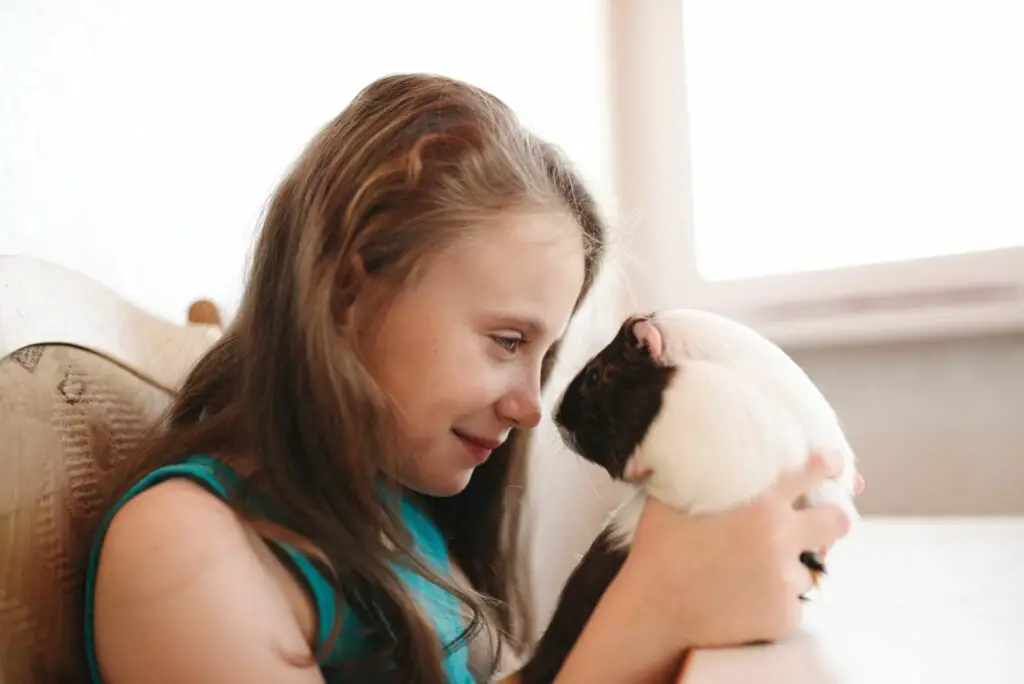If you’re a guinea pig owner, you may have wondered how your furry friend sees the world around them. While guinea pigs may not have the sharpest vision, they still rely heavily on their eyesight to navigate their environment and communicate with their owners.
In this blog post, we’ll explore the physiology of guinea pig eyes, their behavioral response to visual stimuli, and practical implications for their care.

Physiology of Guinea Pig Eyes
Structure of Guinea Pig Eyes
Guinea pigs have a similar eye structure to other rodents, with small, round eyes located on the sides of their head. This placement allows for a wider field of vision, but also creates a blind spot directly in front of them. Additionally, guinea pigs have a third eyelid, or nictitating membrane, which helps to protect and moisten their eyes.
Color Perception in Guinea Pigs
While guinea pigs can distinguish between different colors, they do not see the same range of colors as humans. Guinea pigs are dichromatic, meaning they have two types of color receptors in their eyes, compared to the three types in human eyes. This means that guinea pigs cannot differentiate between certain colors, such as red and green.
Visual Acuity and Field of Vision of Guinea Pigs
Guinea pigs have relatively poor visual acuity, with a visual acuity of around 20/300, compared to human visual acuity of 20/20. This means that guinea pigs cannot see fine details or small objects very clearly. However, they do have a wide field of vision, with a visual field of around 340 degrees.
How Guinea Pigs See in Low Light Conditions
Guinea pigs have poor night vision and rely on their sense of smell and hearing to navigate in low light conditions. They also have larger pupils than humans, which allows more light to enter their eyes.
Behavioral Response to Visual Stimuli
How Guinea Pigs React to Different Colors
While guinea pigs can distinguish between some colors, they do not appear to have a strong preference for any specific color. However, some research suggests that guinea pigs may prefer brighter colors and patterns.
Guinea Pig Reaction to Different Lighting Conditions
Guinea pigs prefer bright light and may become stressed or anxious in dimly lit environments. However, they can become overwhelmed by bright light and may hide or seek shelter in darker areas.
How Guinea Pigs Use Vision to Navigate Their Environment
Guinea pigs use their vision to navigate their environment and locate food and water sources. They are also able to recognize their owners and other guinea pigs through visual cues.
Reactions to the Presence of Predators or Threatening Stimuli
Guinea pigs have a strong instinct to avoid predators and threatening stimuli. They may freeze or hide when they sense danger, and may also emit warning calls to alert other guinea pigs to the presence of a predator.
Practical Implications for Guinea Pig Care
Factors to Consider for Guinea Pig Housing and Enclosures
When designing a guinea pig enclosure, it’s important to consider their visual needs. Provide a well-lit environment with plenty of hiding places and shade options. Avoid using bright, neon colors or patterns, as these can be overwhelming for guinea pigs.
How to Create an Enriched Environment for Guinea Pigs
Guinea pigs benefit from an enriched environment that provides visual, auditory, and olfactory stimulation. Include plenty of toys and objects to explore, and vary their placement to keep things interesting. Provide safe, edible plants and grasses to graze on, and rotate their selection regularly.
How to Recognize Signs of Vision Problems in Guinea Pigs
Signs of vision problems in guinea pigs may include frequent blinking, cloudy or red eyes, and a reluctance to move around their environment. If you suspect your guinea pig is having vision problems, consult with your veterinarian.
Best Practices for Handling and Interacting with Guinea Pigs
When handling and interacting with guinea pigs, be mindful of their visual limitations. Approach them slowly and from the side to avoid startling them, and avoid sudden movements or loud noises. Speak to them in a calm, soothing tone to help them feel comfortable and secure.
Conclusion
While guinea pigs may not have the sharpest vision, they still rely heavily on their eyesight to navigate their environment and communicate with their owners.
Understanding their visual needs can help you provide the best possible care for your furry friend. By providing a well-lit, enriched environment and handling them with care, you can help your guinea pig see the world in a safe and comfortable way.
- How Long Do American Eskimo Dogs Live? Important Factors and Care Tips - September 29, 2023
- Do American Bulldogs Need Grooming? Essential Tips and Care Guidelines - September 29, 2023
- Do Bengal Cats Enjoy Playing? Essential Tips for Keeping Them Active - September 29, 2023